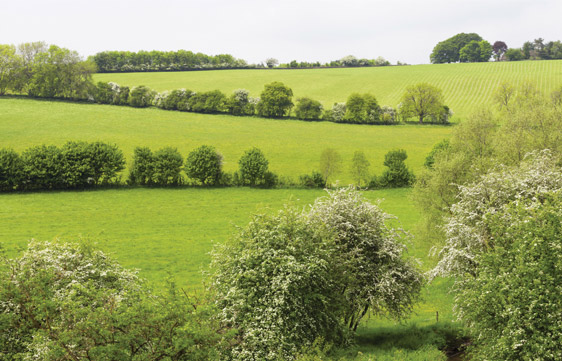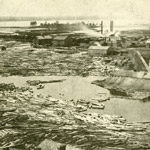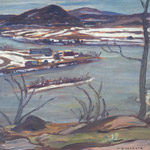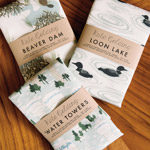
Windbreak, buffer, treeline, green fence, field margin, shelterbelt, fence line, hedgerows…some of the terms used to describe the living corridors that bend and flow along country roads and fields, creating the patchwork of our rural landscapes.
AT FIRST GLANCE, YOU MAY DISMISS HEDGEROWS AS ROADSIDE BRUSH OR OVERGROWN FENCES BUT IN FACT, THEY ARE AN INTEGRAL PART OF THE LANDSCAPE AND THE LOCAL ECOLOGY. With varied margins of sumac, serviceberry, dogwood, soft maple, cedars and the flowers of ruderal perennials and grasses, hedgerows are among the last remaining fragments that tie us to the rich cultural and agricultural heritage that characterizes our unique part of Ontario.
Many of the hedgerows that remain today follow the path of the original survey lines established and mapped out by the Crown. Ernest Margetson, an engineer, designer, heritage advocate and member of the Prince Edward County (PEC) Council, describes how the location of hedgerows frame their cultural context: “The layout and delineation of the fields within a farm were not accidental… The size of the fields reflect …how much land could be cleared and prepared in one season. Also, it is evident that soil type and depth, topography, and drainage patterns also influenced the location of fences and field pattern.”
Fast forward a couple of hundred years and you might ask, “What good are hedgerows in today’s world?” Beyond their physical beauty and cultural value, hedgerows are critical to the local wildlife population, providing shelter, food, breeding sites and a protected travel corridor that allows birds, animals and even insects to move between habitats. Living fence lines also help farmers to retain water in field soils; they act as wind protection to reduce soil erosion and, with the right mix of species, they attract pollinators to support crop yields.
When we cross-country ski across the fields in the winter, cycle the back roads in the summer or enjoy a drive in the country to take in the fall colours, hedgerows play an important part in what we experience along the way. And when the winter winds whip across open fields, hedgerows act as natural snow fences.
Unfortunately, many of the familiar hedgerows of Northumberland, Quinte and Prince Edward Counties are disappearing from the rural landscape. In less than a generation, the living seams that connect us to our cultural history and facilitate wildlife habitat are being removed as larger corporate farms cultivate greater swaths of land, as township roads are widened and as hydro lines are cleared. But, there are a variety of efforts afoot in Ontario that offer hope and practical solutions to the problem.
Alternative Land Use Services (ALUS) Canada is an initiative funded to tackle the complex and challenging relationship between agriculture and wildlife. ALUS works directly with farmers “to offer economic incentives in exchange for their efforts that support the healthy ecosystems – clean air, clean water, flood mitigation, climate adaptation, carbon sequestration, species at risk habitat and all our native bees and pollinators – on which their food production relies.” ALUS believes that “As the largest single group of landowners in Canada, agricultural producers are in a unique position to provide important solutions to some of the most pressing conservation challenges of our time, including climate change and biodiversity loss.”
Elizabeth Kellogg, a Port Hope-based naturalist and member of a large farming family, sees the value of the ALUS program: “It’s much easier for farmers to listen to other farmers,” and hopes the program will spread to eastern Ontario where the need is great.
At this point, there are no farmer-led ALUS projects in the Quinte, Prince Edward, or Northumberland areas but Hillier-based organic farmer and farm-to-table chef Jamie Kennedy has invited ALUS to meet with a group of local County farmers who are curious to know more.
Through the Species at Risk Farm Incentive Program funded by the Ontario Ministry of Natural Resources and Forestry, the Corridors Connecting Habitat program supports the planting of native grasses, legumes, herbaceous plants, trees, and/or shrubs as fencerows, field edges, or on marginal lands to connect natural areas. Hedgerows don’t necessarily need to be tall or biologically diverse to provide ecosystem benefits. Even a line of low grasses can achieve ecological benefits for small insects and reduce erosion of field soils.
In Prince Edward County, a local branch of the Natural Heritage Conservation (NHC-PEC) is raising awareness around the value of hedgerows in the rural landscape and the need for natural heritage discussions in local land use decisions, especially adjacent to ecologically and culturally sensitive sites. The group has begun discussions with local environmental groups, Quinte Conservation, and is meeting with members of the municipal council to propose amendments to the Official Plan that will acknowledge the importance of hedgerow protection in planning decisions.
Admitting there is difficult work ahead in a community where farmers face tough economic pressures, NHC-PEC’s executive committee is encouraged by recent meetings and a quickly growing base of supporters. As Elizabeth Blomme, a member of the group explains, “What we’re really looking for is cooperation from all landowners. We’re prepared to take the time to work towards a new approach that respects both the health of the land and the rights and needs of landowners and the farming community.” Their next steps are to build support from and within the agriculture community and gather updated land-based data to assess what has been lost.
While NHC-PEC secures updated data, they welcome local residents who have witnessed hedgerow loss to post pictures and stories on the group’s Facebook page. Based on anecdotal stories combined with hard data, the group suspects that the combined results will generate the public and political momentum that is needed to protect what is left and begin to recover what has been lost.
Whether intentionally planted to keep in livestock, left as a remnant edge of field and farm boundaries, an evolved accidental ecology seeded by wind or birds resting on a field boundary post, hedgerows are dynamic living strips that need to be recognized for their contribution to the life we cherish in rural Ontario.
For more information about the Natural Heritage Conservation in Prince Edward County, email Elizabeth Blomme at elizabeth@finkelsteinmanagement.com or Bill Bonter at billbonter@yahoo.ca.
The preceding includes excerpts from an article published under the same title in Ground: Landscape Architect Quarterly published by the Ontario Association of Landscape Architects.
Story by:
Victoria Taylor, Landscape Architect, MES, MLA, OSL




